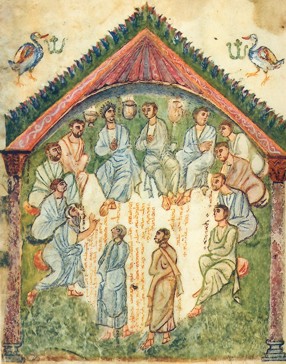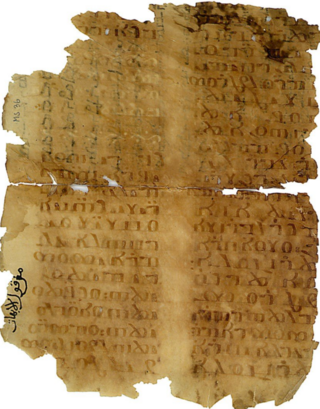In textual criticism of the New Testament, the Western text-type is one of the main text types. It is the predominant form of the New Testament text witnessed in the Old Latin and Syriac Peshitta translations from the Greek, and also in quotations from certain 2nd and 3rd-century Christian writers, including Cyprian, Tertullian and Irenaeus. The Western text had many characteristic features, which appeared in text of the Gospels, Book of Acts, and in Pauline epistles. The Catholic epistles and the Book of Revelation probably did not have a Western form of text. It was named "Western" by Semmler (1725–1791), having originated in early centers of Christianity in the Western Roman Empire.

Rabbula was a bishop of Edessa from 411 to August 435 AD, noteworthy for his opposition to the views of Theodore of Mopsuestia and Nestorius. However, his successor Ibas, who was in charge of the school of Edessa, reversed the official stance of that bishopric. Rabbula is not to be confused with the otherwise unknown scribe of the 6th century Rabbula Gospels. Venerated as a Saint by Eastern Orthodox Church and Syriac Orthodox Church (feast December 17/19, August 8, and Third Wednesday after The Easter.

Saint Catherine's Monastery, officially the Sacred Autonomous Royal Monastery of Saint Katherine of the Holy and God-Trodden Mount Sinai, is a Christian monastery located in the Sinai Peninsula of Egypt. Located at the foot of Mount Sinai, it was built between 548 and 565, and is the world's oldest continuously inhabited Christian monastery.

The Peshitta is the standard version of the Bible for churches in the Syriac tradition, including the Maronite Church, the Chaldean Catholic Church, the Syriac Catholic Church, the Syriac Orthodox Church, the Malabar Independent Syrian Church, the Syro-Malankara Catholic Church, the Assyrian Church of the East and the Syro-Malabar Church.
James Rendel Harris was an English biblical scholar and curator of manuscripts, who was instrumental in bringing back to light many Syriac Scriptures and other early documents. His contacts at the Saint Catherine's Monastery on Mount Sinai in Egypt enabled twin sisters Agnes Smith Lewis and Margaret Dunlop Gibson to discover there the Sinaitic Palimpsest, the oldest Syriac New Testament document in existence. He subsequently accompanied them on a second trip, with Robert Bensly and Francis Crawford Burkitt, to decipher the palimpsest. He himself discovered there other manuscripts. Harris's Biblical Fragments from Mount Sinai appeared in 1890. He was a Quaker.

The Aramaic original New Testament theory is the belief that the Christian New Testament was originally written in Aramaic.

The Syriac Sinaiticus or Codex Sinaiticus Syriacus (syrs), known also as the Sinaitic Palimpsest, of Saint Catherine's Monastery, or Old Syriac Gospels is a late-4th- or early-5th-century manuscript of 179 folios, containing a nearly complete translation of the four canonical Gospels of the New Testament into Syriac, which have been overwritten by a vita (biography) of female saints and martyrs with a date corresponding to AD 697. This palimpsest is the oldest copy of the Gospels in Syriac, one of two surviving manuscripts that are conventionally dated to before the Peshitta, the standard Syriac translation.
A biblical manuscript is any handwritten copy of a portion of the text of the Bible. Biblical manuscripts vary in size from tiny scrolls containing individual verses of the Jewish scriptures to huge polyglot codices containing both the Hebrew Bible (Tanakh) and the New Testament, as well as extracanonical works.

Christian Palestinian Aramaic (CPA) was a Western Aramaic dialect used by the Melkite Christian community in Palestine and Transjordan between the fifth and thirteenth centuries. It is preserved in inscriptions, manuscripts and amulets. All the medieval Western Aramaic dialects are defined by religious community. CPA is closely related to its counterparts, Jewish Palestinian Aramaic (JPA) and Samaritan Aramaic (SA). CPA shows a specific vocabulary that is often not paralleled in the adjacent Western Aramaic dialects.

Agnes Smith Lewis (1843–1926) and Margaret Dunlop Gibson (1843–1920), nées Smith, were English Semitic scholars and travellers. As the twin daughters of John Smith of Irvine, Ayrshire, Scotland, they learned more than 12 languages between them, specialising in Arabic, Christian Palestinian Aramaic, and Syriac, and became acclaimed scholars in their academic fields, and benefactors to the Presbyterian Church of England, especially to Westminster College, Cambridge.

Codex Nitriensis, designated by R or 027, ε 22, is a 6th-century Greek New Testament codex containing the Gospel of Luke, in a fragmentary condition. It is a two column manuscript in majuscules, measuring 29.5 cm by 23.5 cm.

Bible translations into Aramaic covers both Jewish translations into Aramaic (Targum) and Christian translations into Aramaic, also called Syriac (Peshitta).

Syriac is a dialect of Aramaic. Portions of the Old Testament were written in Aramaic and there are Aramaic phrases in the New Testament. Syriac translations of the New Testament were among the first and date from the 2nd century. The whole Bible was translated by the 5th century. Besides Syriac, there are Bible translations into other Aramaic dialects.

Dura Parchment 24, designated as Uncial 0212, is a Greek uncial manuscript of the New Testament. The manuscript has been assigned to the 3rd century, palaeographically, though an earlier date cannot be excluded. It contains some unusual orthographic features, which have been found nowhere else.
Codex Phillipps 1388, Syriac manuscript of the New Testament, on parchment. It contains the text of the four Gospels. Palaeographically it had been assigned to the 5th/6th centuries. It is one of the oldest manuscripts of Peshitta with some Old Syriac readings.
The Crawford Aramaic New Testament manuscript is a 12th-century Aramaic manuscript containing 27 books of the New Testament. This manuscript is notable because its final book, the Book of Revelation, is the sole surviving manuscript of any Aramaic version of the otherwise missing Book of Revelation from the Peshitta Syriac New Testament. Five books were translated into Syriac later for the Harklean New Testament.
The Harklean version, designated by syrh, is a Syriac language bible translation by Thomas of Harqel completed in 616 AD at the Enaton in Egypt.
Thomas of Harqel was a miaphysite bishop from the early 7th century. Educated in Greek at the monastery of Qenneshre, he became bishop of Mabbug in Syria. He was deposed as bishop by the anti-miaphysite metropolitan Domitian of Melitene before 602. He and Paul of Tella lived as exiles in the Coptic monastery of the Enaton near Alexandria, Egypt. At the request of Athanasios I, they worked on a Syriac translation of the Greek Bible. Translation of the New Testament, known as the Harclensis was completed in 616. At this time, 2 Peter, 2 John, 3 John, Jude and Revelation were added to the Syriac Bible. Until then they were excluded.
The Acts of Sharbel or the Hypomnemata of Sharbel is a Syriac Christian martyrdom text pertaining to a pagan high priest who was martyred for converting to Christianity. The setting takes place at Edessa during the fifteenth year of Roman Emperor Trajan's reign and during the third year of King Abgar VIII's reign but is dated by scholars to the 5th century AD.










